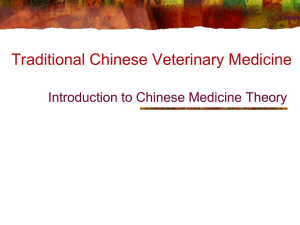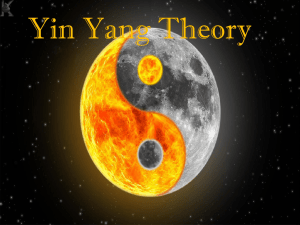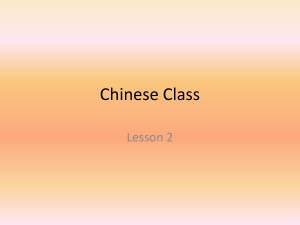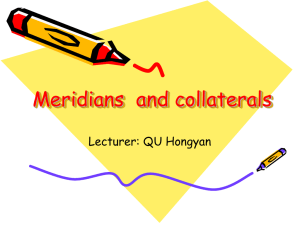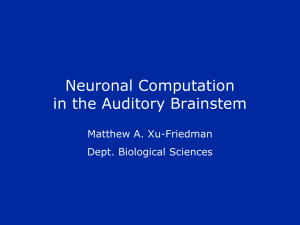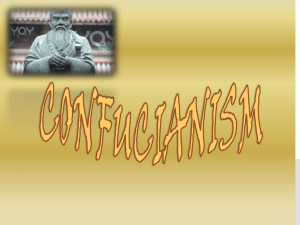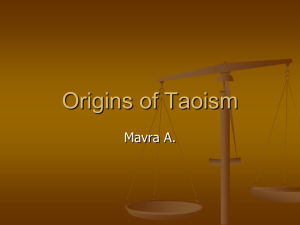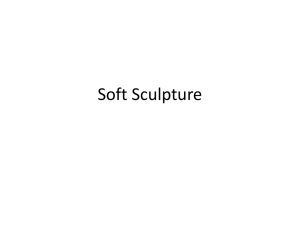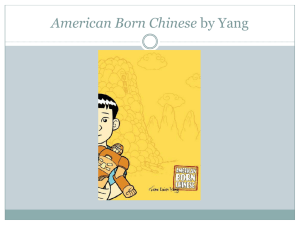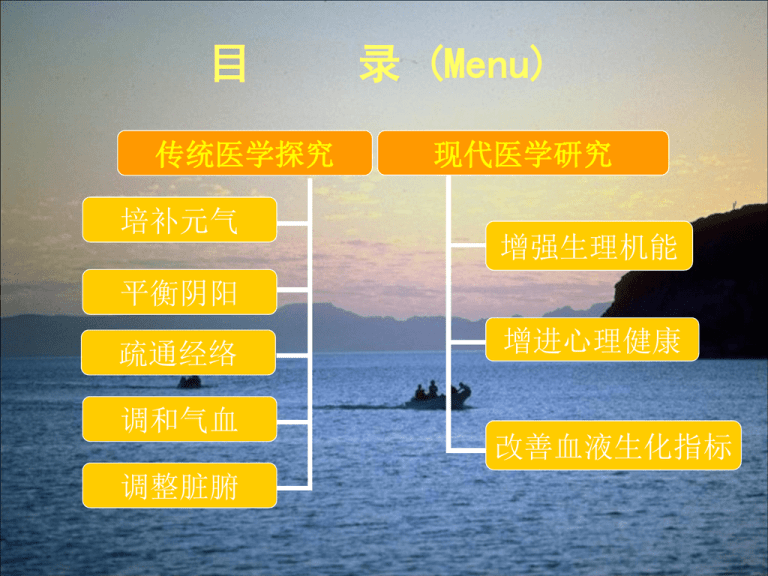
目
传统医学探究
培补元气
录 (Menu)
现代医学研究
增强生理机能
平衡阴阳
疏通经络
调和气血
调整脏腑
增进心理健康
改善血液生化指标
第一节 传统医学探究
一、培补元气-Increase vital energy
中医认为,气是构成人体的最基本的物质
基础,也是人体生命活动的最基本物质。
人体的各种生命活动均可以用气的运动变
化来解释。Traditional Chinese
Medicine (TCM) believe Qi is a basic
component of the body and maintain
the life activities. All life activities can
be explained by the changes of Qi
movements.
气的生成来自于三个方面:
Qi comes from three sources:
1.先天之精气:即受之于父母的先天禀赋之气。
其生理功能的发挥有赖于肾藏精
气;
Vital substance: Inherits from one’s
parents before birth.
2.水谷之精气:即饮食水谷经脾胃运化后所得的
营养物质;
Food essence: Nutrition gained through
digestions.
3.吸入之清气:即由肺吸入的自然界的清气。
Air essence: breath fresh air from
the nature.
气的运动被称为气机,气的功能是通过气机来实现的。
The movement of Qi is called “functional activities of Qi”.
The various functions of Qi are performed by its
movement.
例如,肺呼气为出,吸气为入,宣发为升,肃降为降。又如,
脾主升清,胃主降浊。气机的升降出入应当保持协调、平衡,
这样才能维持正常的生理活动
Four basic ways of Qi movement: Ascending,
Descending, Exiting and Entering. It shows through
physiological functions of Zang Fu, meridians and
collaterals, tissues and organs
气的运动的基本形式包括升、降、出、入四个方面,并体现在
脏腑、经络、组织、器官的生理活动之中。
For example, exhaling is exiting, inhaling is entering,
dispersing is ascending and keeping the inspired air
flowing downward is descending. Qi of spleen is to
ascend and Qi of stomach is to descend. The
coordination & balance of four movements can keep the
physiological functions remaining normal.
元气的概念:是人体生命活动的原始动力,由先天之精所
化生,又受后天水谷之精气不断补充和培养。
Concept of Inborn Qi: Motivation power of the
vital activities of human body. It comes from the
innate essence, and being nourished continuously
by the acquired essence developed from food.
元气是人体中最基本、最重要的,根源于肾,包括元阴、
元阳之气。元气在生命之初,源于父母之精,是生命物质
系统中最高层次、最根本的气,对人体的代谢和机能起推
动和调节作用。
Inborn Qi is the most fundamental and important
of all. It’s from the kidney, including Inborn Qi
of Yin and Yang. Inborn Qi is the innate vital
substance inherits from parents. It’s the most
top and fundamental level of qi within the system
of lives and materials. It can improve and adjust
the metabolism & functions of human body.
健身气功的锻炼,非常重视培补人体元气。
Health Qigong focus on build up the Inborn
Qi.
练功的意守丹田,运动过程中的腰脊运动,都围绕
腰部运动。由于先天之精藏于肾,肾位于腰部,腰
部运动、意守丹田和呼吸锻炼,使肾中元精益固,
“精化为气”,元气自充。
The practice of mind focusing on Dan Tian,
and lower back movements link to the back
exercise. Vital substance is stored in the
kidney, kidney is in the loins at the back.
Back exercise , mind focusing on Dan Tian,
and breathing exercise can fix and improve
the inborn essence in the kidney. Inborn Qi
can be increased when the essence being
transferred into Qi.
二、平衡阴阳
Balance of Yin and Yang
阴阳是中国古代哲学的范畴。阴阳的最初涵义表示阳光
的向背,向日为阳,背日为阴.
Yin and Yang was originally included in the
category of the ancient philosophy of China. At first,
it means whether a place facing the sun or not. The
place being exposed to the sun is Yang, whereas
the place not having a southern exposure is Yin.
后来引申为气候的寒暖,方位的上下、左右、内外,运
动状态的躁动和宁静等。
It extends to the coldness and hotness of weather,
upwards and downwards, left and right, inwards
and outwards of a position, exciting and quiet
during sporting etc.
阴阳学说认为,世界是物质性的整体,自然界的任何事物都包
括着阴和阳相互对立的两个方面,而对立的双方又是相互统一
的。
The world is considered as a whole of materials
according to the theory of Yin and Yang. Everything in
the nature contains the opposite and united relation
between Yin and Yang.
阴阳的对立统一运动,是自然界一切事物发生、发展、变化及
消亡的根本原因。
The movements of opposition & unity of Yin and Yang is
the basic reason that things appear, develop, change and
disappears in the nature.
阴阳的矛盾对立统一运动规律是自然界一切事物运动变化固有
的规律,世界本身就是阴阳二气对立统一运动的结果。
The rules of opposition & unity of Yin and Yang is the
one everything follows in the nature. The world is the
result of these movements.
阴和阳,既可以表示相互对立的事物,又可用来分析一个事物
内部所存在着的相互对立的两个方面。
Yin and Yang can represent opposite things. It also can
be used to analyse the opposite relations within an item.
一般来说,凡是剧烈运动着的、外向的、上升的、温热的、明
亮的,都属于阳;相对静止着的、内守的、下降的、寒冷、晦
暗的,都属于阴。
Normally, all that are: moving, outwards, rising, warm
and hot, bright and clear belong to Yang; while stable,
inwards, falling, cold and cool, dark belong to Yin.
以天地而言,天气轻清为阳,地气重浊为阴;以水火而言,水
性寒而润下属阴,火性热而炎上属阳。
Air is light and clear----Yang; gas is heavy and turbid---Yin.
Water is cold and running downward----Yin; fire is hot
and burning upward------Yang.
健身气功是如何平衡阴阳的
How Health Qigong balance Yin and Yang
1、 动作有阴阳之分:静为阴,动为阳;起势和收功要求分
脚站立,意守丹田,保持安稳姿势;而运动过程则要求绵
绵不断,势势相连。
Movements are distinguished by Yin and Yang:
stable is Yin, moving is Yang. Starting and finishing
the Qigong practice require: standing by using
different legs, mind focusing on Dan Tian, keeping
the position stable and continuation during the
movements.
2、动作方位的上下阴阳之分:动作向上为阳,动作向下为
阴。
Moving upwards is Yang, moving downward is Yin.
3、动作的前后有阴阳之分:动作向前为阳,动作向后为阴。
Moving forward is Yang; moving backward is Yin.
4、劲力有阴阳之分:蓄力为阴,发力为阳。
Holding force is Yin; releasing force is Yang.
5、呼吸有阴阳之分:呼气为阳,吸气为阴。
Breathing: exhaling is Yang; inhaling is Yin.
6、意念运用有阴阳之分:意念向上为阳,意念向下为阴,意念内
收为阴,意念放开为阳。
Mind focusing upward isYang; focusing downward is Yin.
Mind adduction is Yin, opening mind is Yang.
运用阴阳平衡规律指导练功,体会健身气功调整姿势、呼吸锻
炼、意念运用的和谐统一,可以有效地提高练功效果。
It can effectively improve the result of practice following
rules of Yin and Yang balance to feel the harmony & unity of
adjusting posture, breathing exercise, and mind driving by
Health Qigong.
三、疏通经络
Open meridians and collaterals
经络的概念:经络遍布全身,是人体气、血、津液运行的
通道,是联络五脏六腑的生理结构。
Concepts of meridians and collaterals: meridians and
collaterals are distributed over the whole body. They
are the channels Qi, blood, body fluid run through.
They link the five Zang and six Fu together.
经络有广泛而重要的生理作用,概括起来,经络有运行气
血,营内卫外,联络脏腑,病邪传变,诊察病机等作用。
Meridians and collaterals play important roles in the
physiological functions, including moving Qi and
blood, nourishing inside and guarding around the
body, linking the organs.
经脉可分为正经和奇经两类。
Meridians and collaterals can be divided into two
categories: regular and extra meridians.
正经有十二,即手足三阴经和手足三阳经,合称“十二经
脉”,是气血运行的主要通道。
There are 12 regular meridians: three Yin
meridians of the hand and foot, and three Yang
meridians of the hand and foot. They are referred
together as the “Twelve Meridians”, the main
channels for Qi and blood circulation.
奇经有八条,即督、任、冲、带、阴跷、阳跷、阴维、阳
维,合称“奇经八脉”,有统率、联络和调节十二经脉的
作用。
There are 8 extra meridians: Du, Ren, Chong, Dai,
Yinqao, Yangqao, Yinwei, and Yangwei meridians
named as “Eight Extra Meridians”. They command,
link and adjust the 12 regular meridians.
十二经脉—12 Meridians
:
十二经脉又名十二正经,是经络系统的主体。其
命名是根据其阴阳属性,所属脏腑、循行部位综
合而定的。
它们分别隶属于十二脏腑,各经用其所属脏腑的
名称,结合循行于手足、内外、前中后的不同部
位,并依据阴阳学说,给予不同的名称。
12 regular meridians consists main parts of
the meridian and collateral system. They are
named by the individual properties of Yin and
Yang, the organs they pertain, and the areas
they pass.
奇经八脉-- 8 Extra Meridians
奇经八脉是任脉、督脉、冲脉、带脉、阴跷脉、阳跷脉、阴维
脉、阳维脉的总称。它们与十二正经不同,既不直属脏腑,又
无表里配合关系,其循行别道奇行,故称奇经。其功能有:
8 extra meridians are different to the 12 regular
meridians. They do not have any direct relationship
with any of the internal organs, or exterior-interior
coordination between them, and cross differently.
Their functions are:
1.沟通十二经脉之间的联系;
Communicating between 12 regular meridians.
2.对十二经气血有蓄积渗灌等调节作用。
Adjusting the accumulation, storage, infiltration,
and irrigation of Qi & blood within 12 regular
meridians.
任脉,行于腹面正中线,其脉多次与手足三阴及阴维脉交会,能总任
一身之阴经,故称:“阴脉之海”。
Ren Meridian : runs along the midline of the Venter, meets with
the three Yin meridians of the hand and foot as well as the
Yinwei meridian many times, and takes charges of all the Yin
meridians of the whole body. It’s named the “sea of all the Yin
meridians”.
督脉,行于背部正中,其脉多次与手足三阳经及阳维脉交会,能总督
一身之阳经,故称为“阳脉之海”。
Du Meridian : runs along the midline of the back, and meets
with the three Yang meridians of hand and foot as well as the
Yangwei meridian several times, and superintend all Yang
meridians of the body. It’s called the “sea of all the Yang
meridians”.
带脉,起于季胁,斜向下行到带脉穴,绕身一周,如腰带,能约束纵
行的诸脉。
Dai Meridian : starts below the hypochondium, decends
obliguely to the Point Daimai (GB26), then runs transversely
round the waist like a belt. It binds all the meridians of the
body.
健身气功的保健养生作用,通过疏通经络这一
机制来实现。
Health Qigong can show the functions of
keeping and maintaining health by
opening the meridians and collaterals.
练功时,意识注意的部位,大多是腧穴处,腧
穴是经络气血流注汇聚和经气出入的地方,腧
穴是人体脏腑经络气血输注出入的特殊部位。
When we practise, most of the time we
should pay attention to the acupoints,
which are the special places Qi and
blood infuse together and move in & out.
“腧”通“输”,或从简作“俞”。“穴”
是空隙的意思。腧穴并不是孤立于体表的
点,而是与深部组织器官有着密切联系、
互相输通的特殊部位腧穴又是疾病的反应
点和治疗的刺激点。
Acupoints are not just the single
points around the surface of body.
They have close linkage with the
internal organs and are open with each
other. They are also the reflecting
points of sickness and points for
treatments.
健身气功疏通经络的作用
Functions of opening meridians and collaterals
1、功法中有不少动作要求意想膻中、命门、劳宫、涌泉等穴,就是为
了加强经气的流注和畅通。以意引气,多见循经络运行,这种经气传
感现象,通过锻炼可以获得。
Many practices require imagination of Points of Tan Zhong,
Ming Men, Lao Gong , Yong Quan and so on. The purpose is to
enhance the flowing and smooth of Qi. It’s common to drive the
Qi flowing by mental power or imagination following the
meridians. This kind of Qi sensing phenomenon can be
obtained through the Qigong practice.
2、健身气功的肢体活动或按摩拍打,可以触动气血循经络互流。百脉
皆通,气血充盈,在医疗、保健方面有着重要作用。
The physical exercise of Health Qigong can improve the
circulation of Qi and blood. When all the channels are open, Qi
and blood would become full. This is important to the
treatments and maintenance of health.
四、调和气血
Balance Qi and Blood
气血是构成人体的重要组成部分,是维持人体生命活
动不可缺少的精微营养物质。
Qi and blood are important components of
human body, and essence of vitality supporting
human life activities.
气具有推动、温煦、防御、固摄和气化等作用。
Qi has functions of pushing, warming-up,
defending, fixing and transforming etc
血具有营养和滋润等作用。
Blood has functions of
moisturising.
nourishing
and
正常情况下,气血之间维持着一种“气为血之帅,血为气之母”的相
辅相成的动态平衡状态,称谓“气血调和”,而“气血不和,百病乃
变化而生”。
Normally, there is balance condition between Qi and blood that
“Qi is the commander of blood” and “blood is the mother of Qi”.
It’s called the “balance of Qi and blood”. Imbalance and
changes would cause sickness.
健身气功静养时,以意领气,意守丹田,培育元气,可以加强身体的
营养和滋润。
When Convalescing by health Qigong, it can enhance the
nutrition and moisturising level of body by guiding the Qi
using imagination, focusing on Dan Tian, and strengthen
Inborn Qi.
运动时,调动内气在全身周流运行,起到活血化瘀,打通阻塞,推动
调整,促进全身气血循环作用。同时起到灵活关节,强健筋骨的作用。
When practising, using Qi to move over the body. This can
remove the blood stasis, open the blockage, improve the
adjustment and the blood circulation. It also can improve the
flexibility of joints and strengthen the tendons & bones .
五、调理脏腑Regulate internal organs
中医学说将人体器官分为两大类:
Traditional Chinese medical theories
describe organs in two categories:
心、肝、脾、肺、肾称之为脏
;
Zang includes Heart, Liver, Spleen,
Lung and Kidney.
胆、胃、小肠、大肠、膀胱称之为腑。
Fu includes Gallbladder, Stomach,
Small intestine, Large intestine and
Urinary bladder.
健身气功调理脏腑的作用
Functions of regulating internal organs
1、练习健身气功,动作以腰为主宰,腰部命门是其主要锻炼之处,命
门相火旺盛,肾气则充溢。肾阳相火是其他脏腑生理活动的原动力。命
门元阳之火充足,则脾阳得资,脾气充足健运,后天水谷得以消化,精
微物质得以运化,从而为人体脏腑、经络乃至四肢百骸的正常活动提供
了物质基础,这就是健身气功何以能全面增强体质的道理。
To practise Health Qigong, movements should focus on the
loins of lower back. Ming Men is the main area. When the fire
of Ming Men is exuberant, the Qi of Kidney would be full. The
fire of Kidney Yang is the original force supporting other
organs’ physiological activities. When the fire of inborn
Yang of Ming Men is full, the Spleen Yang can be notified.
Full of Spleen Qi can improve the digestion of food. Therefore,
vital essence can be transferred to provide the basic
nutrition supporting normal life activities through the Zang &
Fu organs, meridians & collaterals, and the whole body. This
is why Health Qigong can help strengthen the health.
2、健身气功中的“调心”,就是调心神,心
清神凝,则身安气和,并使魂、魄、意、志
处于协调安定状态, 这样即能使五脏安和,
心身健康。
Adjusting Xin in Health Qigong means
to adjust the heart and spirit. Clear
heart and moral cohesion can bring the
soul & spirit into a calm condition in
order to stabilise the Qi & five Zang
organs and obtain physical and mental
health.
3、健身气功的动作功能,常与五脏对应,比较典型的有六字诀和
五禽戏。
The functions of Health Qigong always link to five Zang.
Liu Zi Jue and Wu Qin Xi are the most typical practices.
六字诀的“嘘、呵、呼、呬、吹、嘻”六音分别对应肝、心、
脾、肺、肾和三焦。
The mouth forms of Liu Zi Jue: Xu, He, Hu, Si, Chui and
Xi are linked to Liver, Heart, Spleen, Lung, Kidney and
Sanjiao (the three portions of the body cavities housing
the internal organs).
五禽戏根据“虎、鹿、熊、猿、鸟”五种动物的秉性特点寓有
锻炼肝、肾、脾、心、肺的作用。
Wu Qin Xi is imitating the characteristic behaviours and
movements of five animals: Tigers, Deer, Bears, Monkeys
and Birds. It also can strengthen the functions of Liver,
Heart, Spleen, Lung, Kidney
第二节 现代医学研究
Chapter 2 Modern medical theories
一、增强生理机能--Strengthen physiological
functions
1.提高反应速度--Increase reaction speed
2.增强肌肉力量--Develop muscle strength
3.提高柔韧性---Develop flexibility
4.改善平衡能力--Improve balancing ability
5.健美体形
----Sharp body shape
6.改善身体机能--Improve body functions
二、增进心理健康
Build up mental health
1.提高心理健康水平
Increase physical and mental
health level
2.提高注意力集中
Improve concentration
三、改善血液生化指标
Improve blood biochemistry index
1.自由基
Free radical
2.免疫调节能力
Immunoregulation capability
3.血脂代谢
Cholesterol Metabolism
4.性激素
Sex Hormone
上述观点,
作为探索,仅供参考
Above points & opinions are
for reference only

